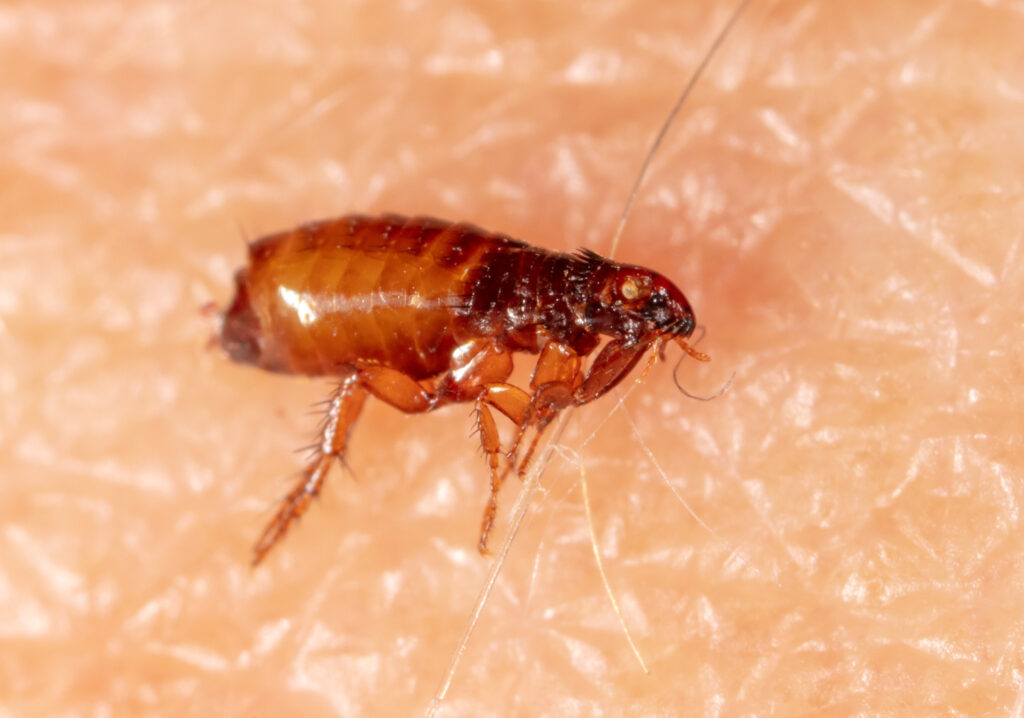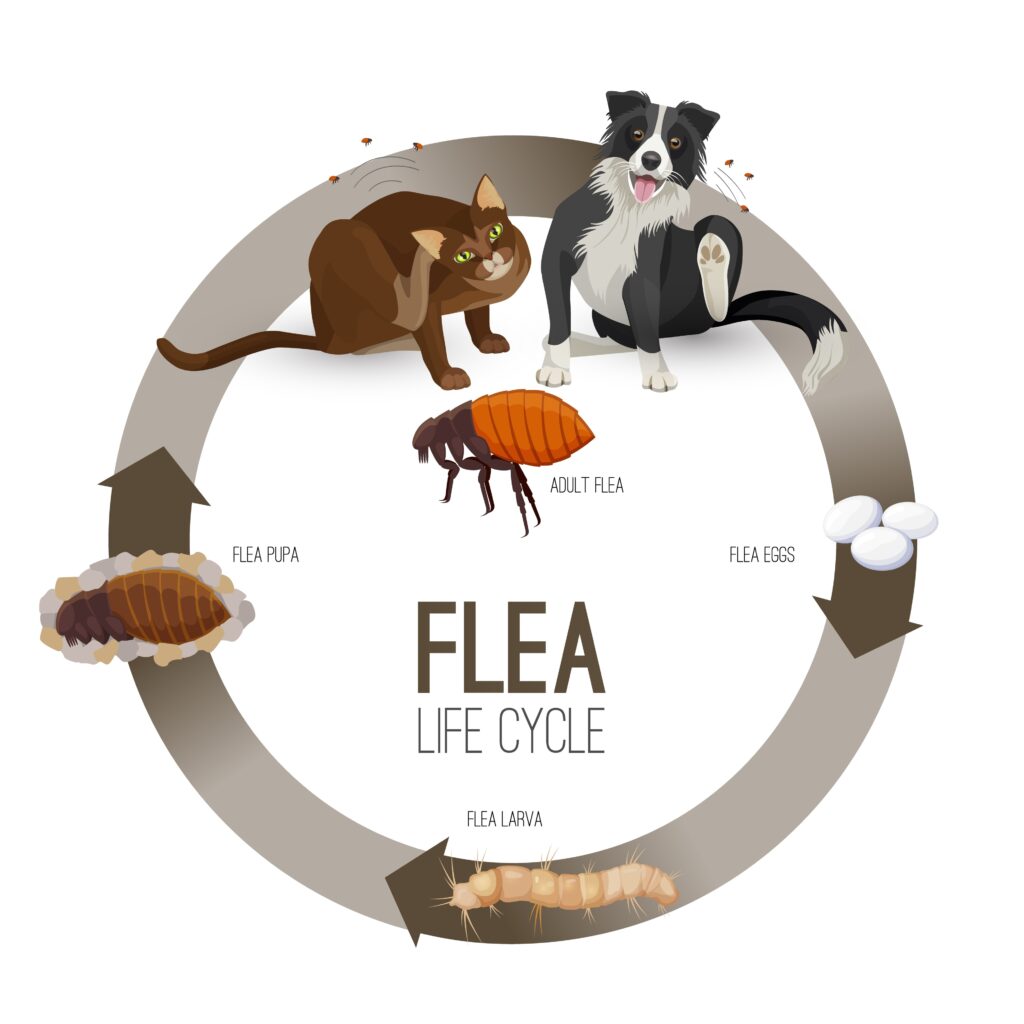Introduction
What Does a Flea Look Like? Every homeowner, pet owner, or anyone who has ever experienced the insistent itch of a flea bite understands the importance of recognizing these tiny pests on sight. Fleas, though minute, pose significant concerns not just for our furry companions, but also for us. By accurately identifying them, we stand a better chance of implementing effective extermination strategies. In this comprehensive guide, we’ll dive deep into the distinctive appearance and characteristics of fleas. Armed with this knowledge, you’ll be better prepared to address flea infestations head-on, ensuring a comfortable living environment for both you and your pets. According to the Center for Disease Control and Prevention (CDC), fleas are known vectors for several diseases, making their identification and control all the more crucial. Join us on this journey as we reveal the world of fleas from a perspective you might never have considered before.
The Basic Anatomy of a Flea
As you delve into the intricate world of these diminutive creatures, it becomes evident that fleas are marvels of evolution, designed specifically for their parasitic lifestyle. Every aspect of their anatomy, from their robust exoskeleton to their powerful legs, serves a unique purpose, ensuring their survival and proliferation.
Body Structure

Fleas possess a tough and durable exoskeleton, which grants them an impressive resilience against common extermination methods. This external skeleton not only provides protection but also aids in retaining moisture, vital for their survival. Their body is divided into three distinct regions: the head, thorax, and abdomen. Each segment has evolved with specific functions in mind, from hosting sensory organs to aiding in locomotion and reproduction.
Legs: Built for Jumping
Arguably the most recognizable feature of a flea is its hind legs. Crafted for jumping, these legs can propel the flea over distances many times its body length. This remarkable ability allows them to navigate through fur, hair, and across hosts with unparalleled ease, making them elusive targets. The muscle structure and joint mechanism of these legs are so advanced that they’ve been studied by scientists and engineers for bio-inspired designs.
Mouthparts: Tools for Feeding
When it comes to feeding, fleas are equipped with specialized mouthparts designed for piercing the skin and sucking blood. This adaptation ensures they get their required nutrients directly from their hosts. They secrete saliva containing anticoagulants, ensuring the blood doesn’t clot while they feed. This very process, as detailed by Entomology Today, is what can cause the itchy and often inflammatory reaction in humans and animals post a flea bite.
Color and Size: Distinctive Flea Features
One might think that spotting a flea would be a straightforward task, but these pests have evolved to blend seamlessly into their environment, making them masters of disguise. Recognizing the typical coloration and size of fleas is pivotal in ensuring that we’re dealing with the right culprit and not misidentifying another insect as our foe.
Typical Coloration Patterns
Fleas are generally characterized by shades ranging from dark brown to reddish-brown. This earthy coloration provides them with a natural camouflage. Especially when they’re nestled deep within the fur or hair of their hosts. Their tint is not just a result of evolution for disguise. But it’s also influenced by their diet, which primarily consists of blood from their hosts.
Size Comparison
In terms of size, adult fleas are tiny, usually measuring between 1/16 to 1/8 inch long. To visualize this, consider that an adult flea is roughly the size of a pinhead or a speck of pepper. However, don’t be deceived by their small stature. Despite their diminutive size, they possess the power to cause significant discomfort to their hosts and can quickly infest an environment if left unchecked. As PestWorld outlines, understanding the typical size of a flea is paramount in distinguishing them from other pests and ensuring the right extermination approach.
Flea Lifecycle Stages: From Egg to Adult

To effectively combat and control a flea infestation, one must first understand their entire lifecycle. Like many pests, fleas don’t merely appear in their recognizable adult form; they go through a series of developmental stages. Each stage presents its own challenges and requires unique strategies to manage. By acquainting ourselves with this lifecycle, we can target fleas at their most vulnerable phases, ensuring a more comprehensive eradication. What Does a Flea Look Like?
Eggs:
Flea eggs are the genesis of the infestation cycle. These tiny, white, and pearl-like orbs are often sprinkled by adult fleas into the environment, typically in places where the host rests. Due to their minuscule size and color, they can easily be mistaken for dandruff or grains of sand. However, each egg harbors the potential to develop into a voracious adult flea.
Larvae:
Emerging from the eggs are the flea larvae. Tiny, worm-like creatures that shun light and burrow deep into carpets, cracks, and soils. They feed on organic debris, but most importantly, on the feces of adult fleas which are rich in undigested blood. This phase of their lifecycle is when they’re most vulnerable, as environmental disruptions can easily disturb their development.
Pupae:
The next stage is the pupal phase, wherein the larvae encase themselves in a silk-like cocoon. This cocoon offers protection, allowing the developing flea to undergo metamorphosis. The pupal stage can vary in length, with some fleas emerging within a week. While others can remain dormant for months, awaiting the right conditions or stimuli, like the vibration from footsteps or warmth.
Adult Fleas:
Out of the cocoon emerges the fully formed adult flea, ready to find a host and feed. As noted by The Spruce Pets, the lifespan of an adult flea, while short. Typically ranging from two weeks to several months—is marked by rapid reproduction, laying as many as 50 eggs a day. It’s this prolific nature that underscores the importance of early identification and intervention.
Comparing Fleas to Other Common Insects
What Does a Flea Look Like? Given the plethora of small, biting insects that can invade our homes and plague our pets, it’s easy to mistakenly identify one insect for another. To ensure the effectiveness of treatment strategies and prevent undue distress, it’s essential to differentiate fleas from other similar pests. By drawing clear distinctions between these insects, we can tailor our extermination methods accordingly, ensuring optimal results.
Fleas vs. Bed Bugs:
At a cursory glance, fleas and bed bugs might appear somewhat similar. Both are small, wingless, and feed on blood. However, there are key differences. Fleas, as we’ve discussed, are typically dark brown and possess a more elongated body, while bed bugs are flatter and more oval-shaped. Furthermore, while fleas are notorious jumpers, bed bugs lack this ability and tend to crawl to their destinations. Their bites also differ: flea bites often manifest as small, clustered itchy spots, while bed bug bites tend to be in a linear or zigzag pattern.
Fleas vs. Ticks:
Ticks, like fleas, are bloodsuckers, but they belong to the arachnid family, meaning they are more closely related to spiders. They have a more rounded body structure and lack the powerful hind legs that characterize fleas. Additionally, while fleas may bite and move, ticks latch onto their host, embedding their mouthparts into the skin, sometimes for days. According to the American Kennel Club (AKC), ticks can transmit a host of diseases, further emphasizing the need to differentiate between them and fleas.
Fleas vs. Lice:
Lice are another group of pests that thrive on blood, particularly found in the hair and scalps of humans. They are larger than fleas, have a flatter body, and their six legs are of equal length, unlike the distinctively long hind legs of fleas. Lice infestations are also more localized, often restricted to hair, whereas fleas can be found all over the body and in the environment.
Common Misconceptions About Flea Appearance
In our journey to understand and combat fleas, it’s not just the facts we need to arm ourselves with, but also the discernment to sift through prevailing myths and misconceptions. Over time, several myths about flea appearance and behavior have taken root, which can lead to ineffective treatments or misguided prevention strategies. By debunking these myths, we position ourselves better to tackle these persistent pests head-on.
Debunking Myths:
One widely held misconception is that fleas are only a problem in homes with pets. While pets can indeed be primary hosts, fleas can infest any space, hitching rides on clothing or luggage. Another myth is the belief that fleas are too tiny to be seen with the naked eye. In reality, while they are small, adult fleas are entirely visible, especially when moving against a light background.
Clearing up Common Points of Confusion:
Often, fleas are mistaken for other pests like mites or even simple specks of dirt. Their quick movements and ability to hide deep within fabrics can further this confusion. Additionally, some believe that cold climates are flea-free. However, while fleas thrive in warmer temperatures, they can survive in colder climates, especially indoors. The Environmental Protection Agency (EPA) emphasizes that understanding the true nature and behavior of fleas is instrumental in devising effective pest control strategies. What Does a Flea Look Like?
Why Identifying Fleas Correctly Matters
In the quest to maintain a flea-free environment, the ability to correctly identify these pests is not merely a matter of academic interest—it is a practical necessity. Misidentification can lead to the application of inappropriate treatments, resulting in wasted time, resources, and continued discomfort. Moreover, knowing what we’re up against can mean the difference between temporary relief and a comprehensive, long-term solution. What Does a Flea Look Like?
The Risk of Misidentification:
When we mistake another insect for a flea or vice versa, we might end up applying treatments that are ineffective against the actual culprit. For instance, while certain sprays might work wonders against fleas, they might be futile against other pests like bed bugs. Misidentification can thus prolong infestation cycles, escalate costs, and even expose inhabitants to unnecessary chemicals.
The Benefits of Accurate Knowledge:
On the flip side, accurately identifying fleas allows for targeted extermination methods. It ensures that the right strategies—from choosing the correct repellents to understanding the flea’s life cycle and behavior—are applied. As highlighted by PetMD, tailored treatments based on correct identification can break the lifecycle of fleas, preventing future infestations and offering lasting peace of mind.
Conclusion: What Does a Flea Look Like?
As we conclude our in-depth exploration into the world of fleas, it becomes evident that the battle against these minute pests extends beyond mere extermination—it’s about equipping ourselves with knowledge and remaining ever vigilant. By mastering the art of identifying fleas, understanding their lifecycle, and differentiating them from other pests, we position ourselves as empowered, informed individuals ready to tackle any flea challenge head-on.
The Importance of Continuous Learning:
The realm of entomology, especially concerning fleas, is vast and ever-evolving. New research, findings, and methods of control continually emerge. Staying updated, perhaps by subscribing to journals like the Journal of Medical Entomology, ensures we’re always a step ahead of these pesky invaders. What Does a Flea Look Like?
Encouragement to Stay Vigilant and Proactive:
The fight against fleas is ongoing. Regular checks, especially for pet owners, proactive cleaning, and a keen eye can prevent minor infestations from ballooning into larger issues. Remember, knowledge is power. With the insights gained from this guide and a proactive stance, we can aspire to a comfortable, flea-free environment.